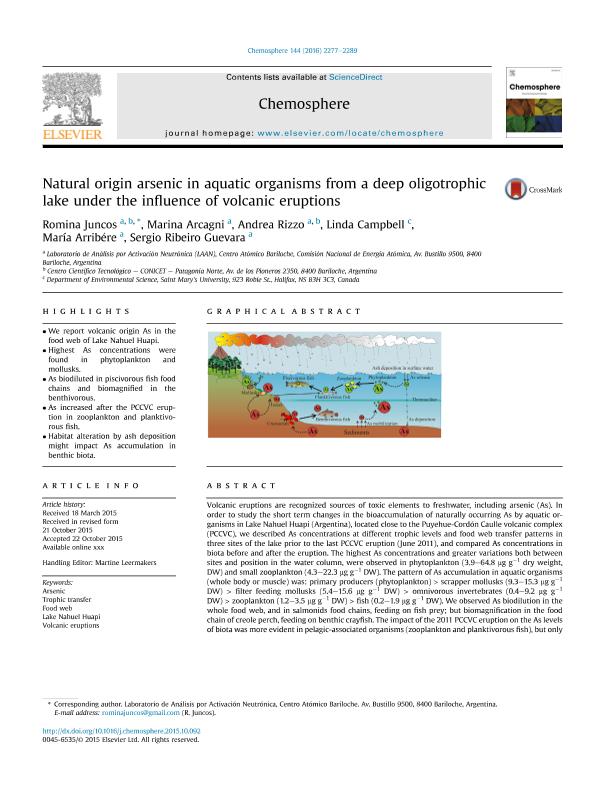Mostrar el registro sencillo del ítem
dc.contributor.author
Juncos, Romina

dc.contributor.author
Arcagni, Marina

dc.contributor.author
Rizzo, Andrea Paula

dc.contributor.author
Campbell, Linda
dc.contributor.author
Arribere, Maria Angelica

dc.contributor.author
Ribeiro, Sergio

dc.date.available
2018-09-17T19:18:17Z
dc.date.issued
2016-02
dc.identifier.citation
Juncos, Romina; Arcagni, Marina; Rizzo, Andrea Paula; Campbell, Linda; Arribere, Maria Angelica; et al.; Natural origin arsenic in aquatic organisms from a deep oligotrophic lake under the influence of volcanic eruptions; Pergamon-Elsevier Science Ltd; Chemosphere; 144; 2-2016; 2277-2289
dc.identifier.issn
0045-6535
dc.identifier.uri
http://hdl.handle.net/11336/59950
dc.description.abstract
Volcanic eruptions are recognized sources of toxic elements to freshwater, including arsenic (As). In order to study the short term changes in the bioaccumulation of naturally occurring As by aquatic organisms in Lake Nahuel Huapi (Argentina), located close to the Puyehue-Cordón Caulle volcanic complex (PCCVC), we described As concentrations at different trophic levels and food web transfer patterns in three sites of the lake prior to the last PCCVC eruption (June 2011), and compared As concentrations in biota before and after the eruption. The highest As concentrations and greater variations both between sites and position in the water column, were observed in phytoplankton (3.9-64.8 μg g-1 dry weight, DW) and small zooplankton (4.3-22.3 μg g-1 DW). The pattern of As accumulation in aquatic organisms (whole body or muscle) was: primary producers (phytoplankton) > scrapper mollusks (9.3-15.3 μg g-1 DW) > filter feeding mollusks (5.4-15.6 μg g-1 DW) > omnivorous invertebrates (0.4-9.2 μg g-1 DW) > zooplankton (1.2-3.5 μg g-1 DW) > fish (0.2-1.9 μg g-1 DW). We observed As biodilution in the whole food web, and in salmonids food chains, feeding on fish prey; but biomagnification in the food chain of creole perch, feeding on benthic crayfish. The impact of the 2011 PCCVC eruption on the As levels of biota was more evident in pelagic-associated organisms (zooplankton and planktivorous fish), but only in the short term, suggesting a brief high bioavailability of As in water after ash deposition. In benthic organisms As variations likely responded to shift in diet due to coverage of the littoral zone with ashes.
dc.format
application/pdf
dc.language.iso
eng
dc.publisher
Pergamon-Elsevier Science Ltd

dc.rights
info:eu-repo/semantics/openAccess
dc.rights.uri
https://creativecommons.org/licenses/by-nc-sa/2.5/ar/
dc.subject
Arsenic
dc.subject
Food Web
dc.subject
Lake Nahuel Huapi
dc.subject
Trophic Transfer
dc.subject
Volcanic Eruptions
dc.subject.classification
Meteorología y Ciencias Atmosféricas

dc.subject.classification
Ciencias de la Tierra y relacionadas con el Medio Ambiente

dc.subject.classification
CIENCIAS NATURALES Y EXACTAS

dc.title
Natural origin arsenic in aquatic organisms from a deep oligotrophic lake under the influence of volcanic eruptions
dc.type
info:eu-repo/semantics/article
dc.type
info:ar-repo/semantics/artículo
dc.type
info:eu-repo/semantics/publishedVersion
dc.date.updated
2018-09-14T14:03:22Z
dc.journal.volume
144
dc.journal.pagination
2277-2289
dc.journal.pais
Países Bajos

dc.journal.ciudad
Amsterdam
dc.description.fil
Fil: Juncos, Romina. Consejo Nacional de Investigaciones Científicas y Técnicas. Centro Científico Tecnológico Conicet - Centro Nacional Patagónico; Argentina. Comisión Nacional de Energía Atómica. Gerencia del Área de Energía Nuclear. Unidad de Actividad de Ingeniería Nuclear. Laboratorio de Análisis por Activación Neutróica; Argentina
dc.description.fil
Fil: Arcagni, Marina. Consejo Nacional de Investigaciones Científicas y Técnicas; Argentina. Comisión Nacional de Energía Atómica. Gerencia del Área de Energía Nuclear. Unidad de Actividad de Ingeniería Nuclear. Laboratorio de Análisis por Activación Neutróica; Argentina
dc.description.fil
Fil: Rizzo, Andrea Paula. Consejo Nacional de Investigaciones Científicas y Técnicas. Centro Científico Tecnológico Conicet - Centro Nacional Patagónico; Argentina. Comisión Nacional de Energía Atómica. Gerencia del Área de Energía Nuclear. Unidad de Actividad de Ingeniería Nuclear. Laboratorio de Análisis por Activación Neutróica; Argentina
dc.description.fil
Fil: Campbell, Linda. Saint Mary's University; Canadá
dc.description.fil
Fil: Arribere, Maria Angelica. Comisión Nacional de Energía Atómica. Gerencia del Área de Energía Nuclear. Unidad de Actividad de Ingeniería Nuclear. Laboratorio de Análisis por Activación Neutróica; Argentina
dc.description.fil
Fil: Ribeiro, Sergio. Comisión Nacional de Energía Atómica. Gerencia del Área de Energía Nuclear. Unidad de Actividad de Ingeniería Nuclear. Laboratorio de Análisis por Activación Neutróica; Argentina
dc.journal.title
Chemosphere

dc.relation.alternativeid
info:eu-repo/semantics/altIdentifier/doi/https://dx.doi.org/10.1016/j.chemosphere.2015.10.092
dc.relation.alternativeid
info:eu-repo/semantics/altIdentifier/url/https://www.sciencedirect.com/science/article/pii/S0045653515302873
Archivos asociados
